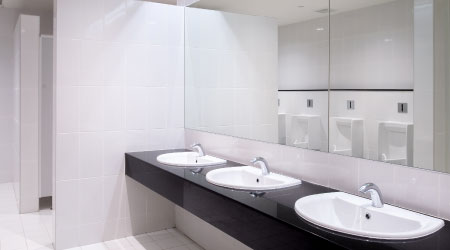Five Factors that Drive Plumbing Upgrades
Product Focus: Plumbing
Plumbing-system upgrades offer managers and their organizations the opportunity to address long-standing performance issues related to restroom fixtures. But which issue — cost, user hygiene, or energy efficiency — should be the deciding factor when specifying new faucets, flush valves, and urinals?
Complicating the decision is the fact that priorities vary by organization. By exploring the reasons for and potential benefits of upgrading plumbing systems, managers will be able to develop more successful strategies for specifying products that address their organizations’ unique set of priorities.
Benefits Check
The five factors that most often drive the decision to upgrade plumbing systems are the components’ age, previous upgrades, severity of use, regulatory mandates, and increases in workloads of maintenance departments due to facility add-ons.
Generally, the older the plumbing system is, the more an upgrade will benefit its operational efficiency. If a building is 35 years old, the amount of deferred maintenance, including the need for replacement with more modern fixtures and piping, probably has grown to the point where operational costs are much higher than for more modern fixtures.
Areas of concern include toilets that use up to four times more water per flush than newer models, taps that discharge water at twice the standard rate, urinals that use too much water, and high leak rates.
Plumbing systems in facilities with high traffic levels — including transportation terminals, schools, hospitals, commercial and government buildings — experience more cycling per day, and components wear out more quickly. These high-volume sites can benefit substantially from upgrades, even if they are only a few years old. Older plumbing systems located in high-traffic areas clearly have the most to gain from upgrades.
Examples of upgrades that can deliver large cuts in operating costs are:
• converting from high gallons-per-flush (gpf) toilets to newer, more efficient flush valves
• converting from manual flush valves to automatic, sensor-operated models
• upgrading to waterless urinals
• converting to paper-saving dispensers
• converting from paper drying to air drying
• upgrading soap dispensers to reduce clogging
• upgrading faucets with lower-flow, hands-free designs.
Managers also must ensure compliance with regulatory mandates, including those in the Americans with Disabilities Act (ADA) and building codes, and those enforced by the Occupational Safety and Health Administration (OSHA).
Finally, increasing a facility’s maintainable space — for example, more lab and research space in schools and more diagnostic areas in hospitals — undoubtedly adds to the maintenance burden related to plumbing systems that serve these new, more complex spaces.
Related Topics:














